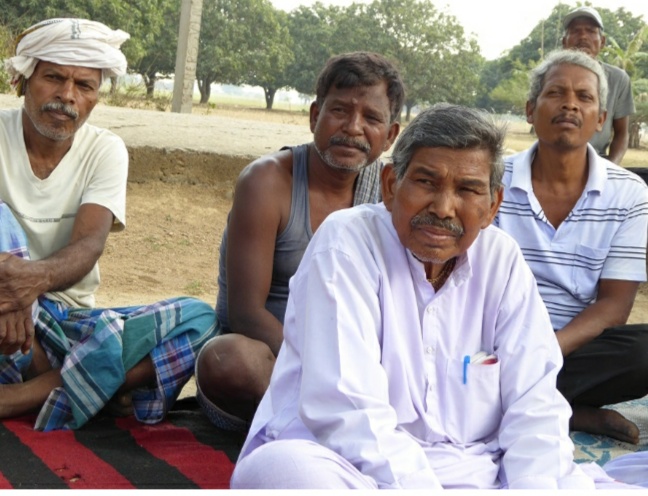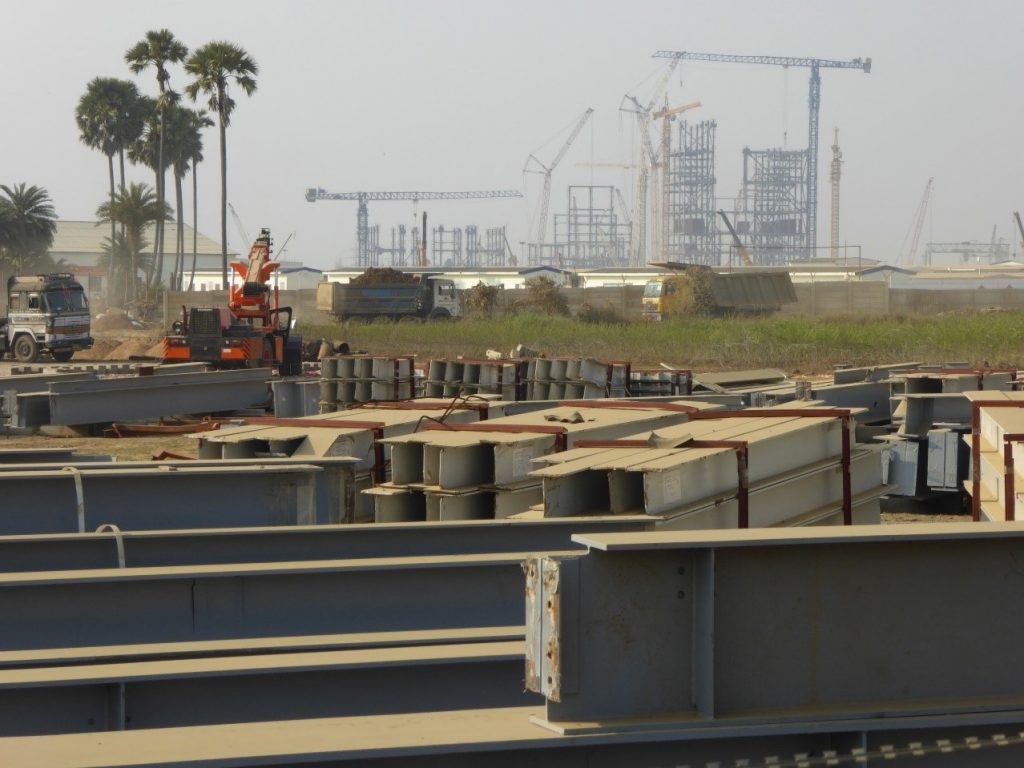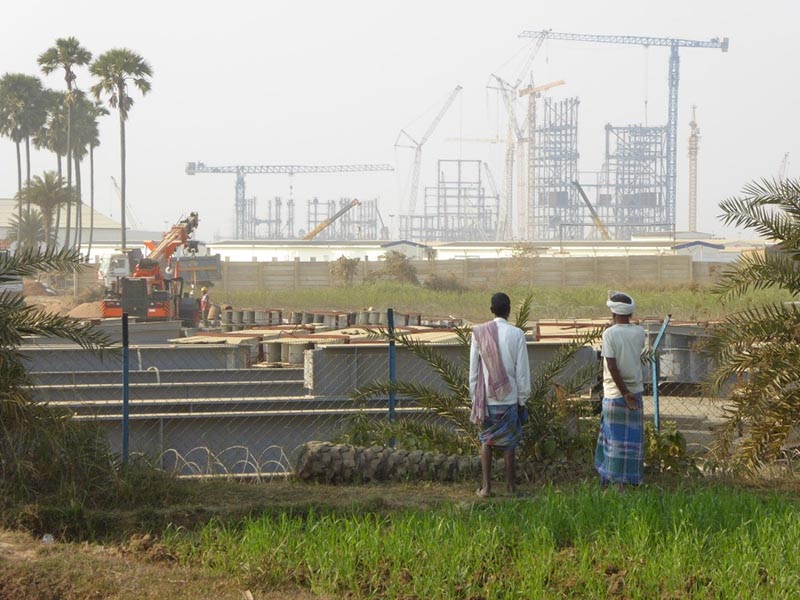by Geoff Law, AdaniWatch
This is an excerpt from the Preliminary Report on the Adani Group’s appalling environmental and social record outside of Australia. It is a ‘preliminary edition’ that is focused on the issues covered by AdaniWatch on its website over the past eight months, completed in September by Geoff Law.
This report deals with Adani’s activities outside Australia. It’s an appalling record of the group’s association with assaults, forced takeover of ancestral lands, environmental degradation, impacts on threatened species and human-rights abuses in India, Myanmar and Indonesia. It presents a case for why ethical contractors or finance companies should think twice before entering into deals with relevant entities within the Adani Group.
This will be an evolving document. Adani’s record within Australia, including its treatment of Ben Pennings and the W&J people, are high on the list for the next topics covered. The various official proceedings against the Group are another obvious inclusion. This article shall be updated as we receive more information – Authors
(This article contains only the part related to Indian operations of the Adani Group Companies.)
1. Assaults on community leaders and other forms of intimidation associated with projects of the Adani Group
(a) The proposed Godda power station (India)
Located in the Indian state of Jharkhand.
Relevant Adani corporate entities: Adani Power (Jharkhand) Limited.
AdaniWatch stories: March 2020, April 2020 and July 2020.
A coal-fired power station is being constructed by Adani Power (Jharkhand) Limited (APJL) near the town of Godda in the eastern Indian state of Jharkhand. This is the power station for which coal from Adani’s Carmichael mine is intended. According to court documents, APJL acquired approximately 550 ha of land for construction of power station.
Many local villagers were forcibly prevented from attending an official meeting that was part of the formal process of acquiring their land. Outside the Social Impact Assessment (SIA) meeting of 16 December 2016, police Adani assaulted the villagers. One villager, Suryanarayan Hembrom, later said ‘We were charged by the police with their batons. Most of us were beaten on that day.’ A newslaundry report has vivid descriptions of the assaults, with one elderly woman saying ‘they attacked my back with bricks’ and another woman saying ‘they hit my child; they beat him badly and started hitting me as well’. These allegations of beatings associated with the forced takeover of land for the Godda power station have acquired great notoriety, having also been covered by the ABC, IndiaSpend and the Business Standard. In response, an Adani spokesperson said the Adani Group ‘neither supports nor has been involved in any act of aggression against any of these stakeholders’. It is true that the SIA meeting was not organised by Adani and that the assaults were carried out by police, not by Adani. However, it can be argued that APJL, the Adani company concerned, was the beneficiary of this violence because its bid to acquire the land in question was ultimately successful at the expense of the villagers who were attacked.

For a more detailed article by Geoff Law of AdaniWatch on this Project
>>> Dirty Tricks and Coercion Used to Acquire Land for Adani’s Godda Power Plant
(b) The proposed Pench Power Station (India)
Located in the Indian state of Madhya Pradesh.
Relevant Adani entities: Pench Thermal Energy (MP) Limited (formerly Adani Pench Power Limited)
AdaniWatch stories: August 2020
Adani took over this languishing project from a state power board in 2010. The proposed power station and associated proposed dam on the Pench River were opposed by local people concerned about the loss of 300 ha of land acquired by the state government of Madhya Pradesh, as well as the environmental impacts and displacement of people. On 22 May 2010, after protesting against Adani’s proposal, Dr Sunilam, a former MLA, and local community campaigner, Advocate Aradhana Bhargav, were viciously assaulted by unknown assailants described in some media reports as ‘company goons’. Sunilam suffered extensive injuries and both his arms were broken. In 2015, the secretary of the community group KSS, Sajje Chandravanshi, and four others were assaulted by unknown assailants. Although these assaults were formally reported to police, no perpetrators were apprehended. When AdaniWatch published a story about the Pench proposal in August 2020, comment from Adani was sought and published, but no comment by Adani was made regarding the allegations of assault by ‘company goons’.
(c) Mundra (India)
Located in the Indian state of Gujarat.
Relevant Adani entities: Adani Ports and Special Economic Zone (APSEZ); Adani Power Limited (APL).
AdaniWatch stories – February 2020, September 2020
At least one leader of protests against APSEZ’s environmental impacts associated with the port, industrial land and power station at Mundra has been bullied by state authorities. In 2015, a leader of the elected village government of Navinal, Mr Gajendrasinh Bhimaji Jadeja, was detained on flimsy charges and later freed by order of the Gujarat High Court. The actions of state authorities in detaining the village leader, who had filed petitions against Adani’s operations, were said to be at the behest of the Adani Group. In preparing a story about impacts at Mundra, AdaniWatch sought comment from Adani about the incident involving Mr Jadeja, but no comment was made.
2. Takeover of indigenous, tribal or ancestral lands
– Godda (India)
Located in the Indian state of Jharkhand.
Relevant Adani corporate entities: Adani Power (Jharkhand) Limited (APJL).
AdaniWatch stories – March 2020, April 2020 and July 2020.

Construction of Adani’s Godda power station proceeds on lands acquired from indigenous
farmers near Godda. Photo by Geoff Law, February 2020
A coal-fired power station is being constructed by Adani near the town of Godda in the eastern Indian state of Jharkhand. This is the power station for which coal from Adani’s Carmichael mine is intended. Land (approximately 550 ha) for the power station was acquired on behalf of APJL by the Jharkhand Government between 2016 and 2018. This was done without the consent of many of the people who own or work on the land. On 6 December 2016, community members opposed to the acquisition of their lands were barred from attending a meeting carried out as part of the Social Impact Assessment of the acquisition. On 31 August 2018, a visceral confrontation occurred between villagers and Adani officials arriving to occupy the lands.
Landowners interviewed by AdaniWatch and a local member of Parliament say that the Jharkhand Government significantly understated the value of the land, thereby reducing the compensation available to landowners. In February 2020, sixteen landowners mounted a legal challenge to the acquisition of their lands in the Jharkhand High Court. The challenge has been reported by the ABC and Scroll.in.
Many of the affected villagers are Adivasi – indigenous people whose land rights are supposed to be protected by law. The subversion of the relevant laws has been described in stories by IndiaSpend and Scroll.in. Dispossessed landowners told AdaniWatch that the loss of land reduces their access to health care, education and a reliable income. Without the land, they said, they will be forced to leave their homeland and seek ‘daily wage labour’ in the cities. In other words, Adani’s Godda power plant will destroy the way of life of a large group of indigenous people.
One of the affected villagers, Suryanarayan Hembrom, told AdaniWatch ‘We will keep fighting. From the district court to the supreme court to the after-life. We cannot stop fighting.’
3. Impacts on endangered wildlife
(a) Elephants in India
Located in the state of Chhattisgarh, India.
Relevant Adani corporate entities: Adani Enterprises Ltd.
AdaniWatch story: June 2020
According to government sources, central India holds 10% of India’s total population of about 27,000 wild elephants. Part of their habitat is the Hasdeo Aranya forest, where the Chhattisgarh state government is in the process of establishing a major elephant reserve.
Unfortunately, thirty coal ‘blocks’ have been identified in the Hasdeo Aranya forest by the Indian government. Five billion tonnes of coal lie beneath the forests and the Adani Group has demonstrated its interest in exploiting this resource. Mining has become a huge business for Adani. Its website lists seven coal mines and two iron-ore mines in Chhattisgarh at which Adani is the ‘mine developer and operator’ (MDO). (Some of these mines are described as ‘under development’.) An active coal mine in the Hasdeo Aranya forest is the Parsa East & Kanta Basan (PEKB) mine, where Adani is MDO for a power company owned by the government of the western Indian state of Rajasthan. Over 100,000 trees were cut down for this mine. Two blocks adjacent to this mine are leased to the same company, and Adani has secured the contract to mine those as well.
According to a Scroll.in article, many elephants have been forced out of the neighbouring state of Jharkhand as a result of mining. The coal-mining operations in Chhattisgarh disrupt the habitat and migration corridors of these elephants. Various reports based on government data say that 325 people and 70 elephants have lost their lives during encounters over the last five years in the Indian state of Chhattisgarh. The PEKB mine and the eight other mines proposed by Adani in Chhattisgarh will exacerbate this conflict, forcing more elephants into cropland, resulting in more deaths of elephants and people alike.
(b) Ganges River dolphin (India)
Located near the town of Sahibganj in the Indian state of Jharkhand.
Relevant Adani corporate entities: Adani Power (Jharkhand) Limited (APJL).
AdaniWatch stories – June 2020
Adani Power plans to draw 36 million cubic metres of water per annum from the lower Ganges for its large power plant at Godda (under construction). This is the power plant for which coal from the company’s Carmichael mine is destined.
A recent government report on the Ganges identified ‘industrialisation’, ‘over-use of natural resources’ and ‘piecemeal engineering operations’ as significant contributors to the river’s continuing degradation. The document said that a new objective of management of the Ganges was to maintain environmental flows. Prime Minister Modi expressed this in the language of the populace when he promised to restore the ‘avralta’ – the free flow – of Mother Ganges. Yet Adani plans to deplete the sluggish river’s waters still further.
The particular stretch of river from which Adani will draw water for its Godda power plant has been identified as important habitat for the endangered Gangetic dolphin, with seven encountered here during a recent survey. According to the species’ entry in IUCN’s ‘red list’, its populations have become ‘severely fragmented’ with a total number somewhere between 2000 and 4000. These remaining dolphins are threatened by pollution, hunting, increasing boat traffic, water diversion and entanglement in fishing nets. The animal is effectively blind; it navigates and forages using echolocation, emitting squeaks and clicks that bounce off nearby surfaces. The dolphins therefore find noise from river vessels and pumping stations disorienting. Adani’s water-pumping infrastructure at Sahibganj could impact the Gangetic dolphin in two ways – through reducing the river’s flow, and through the noise of another major pump.
The Gangetic dolphin is not the only threatened species inhabiting the river near Adani’s proposed pumping station. A species of otter, 89 species of fish, 182 phytoplankton species, and 40 zooplankton species, as well as the seven dolphins, were recorded here in the above survey.
Experts say that the potential impacts of Adani’s development on the Ganges River dolphin and other aquatic species should be properly evaluated. ‘Vision Ganga’ proposes remedies for the stricken river that include maintaining environmental flows, regulating diversions of water, and ensuring transparent scrutiny of planned developments. The need for a comprehensive assessment of the impacts of Adani’s proposed removal of water from the Ganges is therefore clear. Yet, on 3 September 2019, the Ministry of Environment, Forest and Climate Change issued an approval for the Godda power station, including the use of Ganges River water. There had been no open or comprehensive scientific assessment of Adani’s plans, let alone any public participation in the process. The potential impacts on the Ganges River dolphin, on other threatened aquatic wildlife, and on the health of the river appeared to have been ignored. The decision undermined the promise of Prime Minister Modi to restore free flow and health to the Ganges and potentially exacerbates the endangered status of the Ganges River dolphin.
4. Environmental degradation and associated impacts on people
– Mundra (India)
Located in the Indian state of Gujarat.
Relevant Adani entities: Adani Ports and Special Economic Zone (APSEZ); Adani Power Limited (APL).
AdaniWatch stories – February 2020, September 2020
According to its website, APSEZ controls 15,000 ha of industrial land at Mundra on the Gulf of Kutch in the state of Gujarat. Much of this infrastructure has been constructed on what used to be intertidal mud flats. In this industrial estate, APL runs coal-fired power stations with a combined capacity of 4620 MW. Allegations of destruction of the area’s ecological resources and fisheries have been levelled against APSEZ since at least as far back as 2010, with associated denials by APSEZ, media coverage and court cases. The issue was generating controversy as recently as February 2020, with media reports that APSEZ had been exempted from a previous requirement to hold public hearings into proposed expansions.
Studies of areas affected by Adani’s operations at its port and special economic zone at Mundra were carried out by an independent fact-finding committee chaired by a retired judge in 2012-13. The investigation and subsequent report were primarily focussed on the impact of the Tata Mundra Ultra Mega Power Project (UMPP), a massive power plant immediately adjacent to Adani’s infrastructure, but findings heavily implicated the Adani Group as well because the impacts of the two power stations and associated port infrastructure and coal imports in this area are inextricably intertwined. A huge array of impacts was identified, including:
- An increase in alcoholism due to the influx of workers from outside the area. This caused an increase in family violence, adversely affecting large numbers of women and children.
- A 20 to 22% rise in upper respiratory-tract diseases of children, particularly amongst children up to the age of seven. Similar impacts were observed amongst the elderly.
- Pastoralists’ land became covered with coal dust (emanating from the huge coal storages of both power plants) and fly ash (a product of burning pulverised coal). There was a sharp increase in abdominal diseases and miscarriages in cattle. Cattle were dying, not in ones and twos but by the dozen. Adani was forced to provide fodder for the cattle at fixed areas to which the pastoralists had to bring their animals.
- Sapota trees in local plantations were killed; others were degraded.
- Salt pans were contaminated by fly ash and coal dust, adversely affecting approximately 3000 salt panners in an area that is critical for salt production in India.
- The local ecosystem, on which fishing livelihoods depend, was devastated by reclamation of intertidal mud flats, destruction of mangroves, dredging of reefs and waterways, and the blocking of creeks. These were highly productive parts of the marine ecosystem. This seriously impacted the high-value prawn, pomfret and bombil fisheries. The fishing season was drastically reduced and the incomes of 6-7000 fishers in the area declined by 40-45%.
Local victims of these impacts have described their plight in interviews and documentaries.
Subsequent investigations have paid particular attention to Adani’s destruction of mangroves and intertidal mud flats, with some reports saying that Adani’s developments have pushed the high-tide level over 10 km seaward. This is a massive loss of ecologically productive ecosystems with a corresponding loss of fish resources. The associated legal cases and media were based on GIS analysis and leaked maps.
In 2013, the report of the Sunita Narain committee, established by the central government’s ministry of environment and forests (‘the ministry’) to inspect the project, found that APSEZ had breached conditions of its environmental clearance in its treatment of the coastal ecology. The Committee Report observed:
- There had been widespread destruction of mangroves, including 75 hectares on Bocha Island, a conservation zone under the environmental-clearance conditions.
- The company had not taken precautions to guard against blocking of creeks by construction activities, with satellite imagery showing signs of deterioration and loss of creeks.
- The company had not taken stipulated measures to ensure that groundwater is protected from contamination by the huge volumes of seawater transported for use in the thermal power plants.
- The company’s inventory of utilisation and disposal of fly ash was inadequate.
- The company had been less than serious in fulfilling its reporting obligations.
A ‘show cause notice’ for the alleged violations was issued by the ministry dated 30 September 2013, with the ministry reported to have directed APSEZ to restore creeks, mangroves and ‘reclaimed’ land, and to consider returning common land to the control of local communities. This directive was controversially overturned in 2015 (under the newly elected Modi government).
In 2017, the Australian organisation Environmental Justice Australia compiled the Adani Brief, with thorough referencing of original sources pertaining to Adani’s environmental impacts at Mundra and subsequent litigation. Its summary of the tortuous process by which environmental approval of developments at Mundra was conferred in 2015 had the following conclusion:
‘Although not entirely clear, it appears that this environmental clearance retroactively legalises the previous actions that APSEZ had taken without the proper environmental clearance. However, this does not diminish the concern that APSEZ had caused serious environmental harm, and had undertaken significant development for many years, without the required approvals.’
In response, Adani points to the economic benefits of its development and says that it has afforested over 2800 ha of the Kutch coast with mangroves, that the area of mangroves in the vicinity of its Mundra development has increased by over 200 ha since 2011, and that it has provided clean-water facilities and resources to communities in the Mundra area.
The impacts on the ecology of the Gulf of Kutch and associated protests by local communities have also been covered by:
– The Sydney Morning Herald
– The Economic Times;
– Down to Earth.
(b) Godda (India)
Located in the Indian state of Jharkhand.
Relevant Adani corporate entities: Adani Power (Jharkhand) Limited (APJL).
AdaniWatch stories – March 2020, April 2020 and July 2020.
A power station is being constructed by Adani near the town of Godda in the eastern Indian state of Jharkhand. This is the power station for which coal from Adani’s Carmichael mine is intended. The environmental approval granted to the project has been the subject of controversy and legal challenge.
Objectors say that the approval was subject to procedural irregularities, including barring a large group of local people from attending public-consultation meetings. In March 2017, a public meeting was organised as a formal part of the government’s consideration of environmental approval for the project. The public meeting was held at a local high school. The company was required to hear claims relating to the environmental damage that its project might cause and present this information in its Environmental Impact Assessment. According to indigenous villagers (Adivasi) interviewed by AdaniWatch in February 2020, officials and a large contingent of police prevented dissenters from attending the meeting. They were admitted only as proceedings were being officially adjourned.
The environmental approval subsequently obtained by Adani from the Ministry of Environment, Forest and Climate Change, dated 31 August 2017, refers to the ‘public hearing’ of 5 March 2017. It says that the issues raised by attendees consisted of employment, CSR activities, compliance with environmental standards, and ‘greenbelt development in one third (sic) area’. No mention was made of the exclusion of landowners, the premature adjournment of the meeting, or local opposition to the project.
One of the villagers’ main concerns is the degradation of domestic water supplies. Adani plans to draw water from the Ganges River, some 90 km away, and pump it to the project site. But, in 2019 and early 2020, as the pipeline has yet to be laid, the company had been relying on groundwater. According to local sources, Adani bored wells within the land it had acquired and also induced surrounding farmers to dig a further 400 bores and sell Adani the water. This is depleting the groundwater of the entire region to a damaging degree, an action that a local member of Parliament has described as illegal. In February 2020, AdaniWatch was shown water pumped from a well that ran red; it left a dirty residue in cooking pots. AdaniWatch was told this is because Adani’s consumption of water for its construction works has lowered groundwater to the level of iron-rich bedrock. Affected villagers told AdaniWatch that the impacts on their water could be a decisive factor in their decision whether to remain at their villages or to leave the area, abandon their Adivasi way of life, and seek daily wage labour in the cities.
This is a developing report and shall be updated as more updates are received.
Disclaimer: This article has not been edited by AlignIndia Editors.
The opinions expressed within this article are the personal opinions of the author. AlignIndia does not take any responsibility for the content of the article.
Geoff Law is a writer and Wilderness conservationist, author and bushwalker, 2010 Churchill Fellow, works with AdaniWatch and BobBrown Foundation, Australia.


